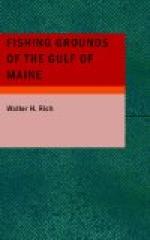Tobins. A name given to a piece of ground about 20 miles square lying S. by E. from the Highland Light. It runs from about 40 miles to about 60 miles offshore, the depths gradually increasing as the bottom slopes away evenly from the shore from 75 to 95 fathoms over a bottom of clay, sand, and pebbles. Cod are taken here in the spring, summer, and fall, and haddock in February, March, and April. A few hake are taken here in summer, but, as compared with the grounds off Chatham, this is not to be considered a hake ground.
Morris Ledge. This lies eastward of Chatham and is a favorite ground for certain cod fishermen during spring and early summer. Schooners and small craft operate here.
Outer Crab Ledge. The center lies about 14 miles ESE from Chatham Lights. It extends about 5 or 6 miles in a N. and S. direction and is about 1 mile wide. Depths run from 19 to 23 fathoms; the bottom is rocky. The fishing is principally for cod in the fall, winter and spring. Vessel fishing here is principally in the spring.
Nantucket Shoals. This stretch of bars and deeper waters between, roughly triangular in form with its apex at the north, lies along the western edge of the South Channel, extending S. and Se. from the southern end of Cape Cod and Nantucket Island. From Monomoy Point to Rogers Fishing Ground, on the eastern edge of Phelps Bank, it is SSE. 80 miles. Its width from Southeast Rips to the western edge of New South Shoal is 40 miles. The area includes a number of “fishing spots” and shoals, among which the following are the most important: Pollock Rip Ground, Rose and Crown Shoal, Great Rip, Davis Bank, Fishing Rip, Old and New South Shoal, and Phelps Bank.
On and about all these shoals the sail fleet makes good catches, mainly consisting of cod but with a fair proportion of pollock, also, and in the deeper water close to them, in spring and summer, a considerable amount of haddock. An occasional large halibut is taken, and even good catches have been reported. There were noted in the daily report of the Boston Fish Bureau between May 15 and August 15, 1920, 10 trips made by the smaller vessels of the halibut fleet that landed fares of from 2,000 to 10,000 pounds of this species from this area. Perhaps more would be taken if the halibut fishery were to be followed here as in other areas. “Rip fishing,” as conducted here, is done “at a drift,” moving over the shoals and, as they move off from them, sailing back to repeat the process. The fish are taken by hand-lining with “cockle” bait or by “jigging” the fish with a shiny piece of metal representing a herring or similar fish, below which are set twin hooks, the fish being struck when it is felt investigating the lure. This fishery generally is carried on during May, June, July, and August. In the mackerel and herring seasons these grounds usually furnish good fishing for these species, the fish usually striking here from May 15 to July 15.




